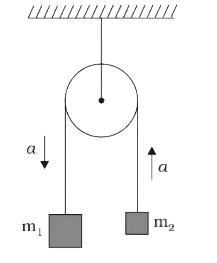A particle of mass m1, makes a head on elastic collision with another stationary body of mass m2 If m1, rebounds with half of its original speed then (m1m2) is
32
23
3
13
To solve the problem of a head-on elastic collision where a particle of mass m1 rebounds with half of its original speed after colliding with a stationary body of mass m2, we can follow these steps:
1. Define Initial Conditions:
- Let the initial speed of mass m1 be v1=v.
- The initial speed of mass m2 is v2=0 since it is stationary.
2. Final Speed of m1:
- After the collision, it is given that m1 rebounds with half of its original speed. Therefore, the final speed of m1 is:
v1f=−v2
- The negative sign indicates that it is moving in the opposite direction after the collision.
3. Using Conservation of Momentum:
- The law of conservation of momentum states that the total momentum before the collision is equal to the total momentum after the collision:
m1v+m2⋅0=m1(−v2)+m2v2f
- Simplifying this gives:
m1v=−m1v2+m2v2f
4. Rearranging the Equation:
- Rearranging the equation to isolate m2v2f:
m1v+m1v2=m2v2f
3m1v2=m2v2f
5. Using Conservation of Kinetic Energy:
- For elastic collisions, kinetic energy is also conserved:
12m1v2+0=12m1(−v2)2+12m2v22f
- This simplifies to:
12m1v2=12m1v24+12m2v22f
- Multiplying through by 2 to eliminate the fractions:
m1v2=m1v24+m2v22f
- Rearranging gives:
m1v2−m1v24=m2v22f
3m1v24=m2v22f
6. Finding the Ratio m1m2:
- From the momentum equation, we have:
v2f=3m12m2v
- Substitute v2f into the kinetic energy equation:
3m1v24=m2(3m12m2v)2
- Simplifying gives:
3m1v24=m2⋅9m21v24m22
- Cancel v2 from both sides (assuming v≠0):
3m1=9m214m2
- Rearranging leads to:
12m1m2=9m21
- Dividing both sides by m1 (assuming m1≠0):
12m2=9m1
- Thus, the ratio m1m2 is:
m1m2=129=43
Final Answer:
The ratio m1m2 is 43.
- Let the initial speed of mass m1 be v1=v.
- The initial speed of mass m2 is v2=0 since it is stationary.
- After the collision, it is given that m1 rebounds with half of its original speed. Therefore, the final speed of m1 is:
v1f=−v2
- The negative sign indicates that it is moving in the opposite direction after the collision.
- The law of conservation of momentum states that the total momentum before the collision is equal to the total momentum after the collision:
m1v+m2⋅0=m1(−v2)+m2v2f
- Simplifying this gives:
m1v=−m1v2+m2v2f
- Rearranging the equation to isolate m2v2f:
m1v+m1v2=m2v2f
3m1v2=m2v2f
- For elastic collisions, kinetic energy is also conserved:
12m1v2+0=12m1(−v2)2+12m2v22f
- This simplifies to:
12m1v2=12m1v24+12m2v22f
- Multiplying through by 2 to eliminate the fractions:
m1v2=m1v24+m2v22f
- Rearranging gives:
m1v2−m1v24=m2v22f
3m1v24=m2v22f
- From the momentum equation, we have:
v2f=3m12m2v
- Substitute v2f into the kinetic energy equation:
3m1v24=m2(3m12m2v)2
- Simplifying gives:
3m1v24=m2⋅9m21v24m22
- Cancel v2 from both sides (assuming v≠0):
3m1=9m214m2
- Rearranging leads to:
12m1m2=9m21
- Dividing both sides by m1 (assuming m1≠0):
12m2=9m1
- Thus, the ratio m1m2 is:
m1m2=129=43
The ratio m1m2 is 43.
Similar Questions
Two bodies of masses m1andm2(<m1) are connected to the ends of a massless cord and allowed to move as shown in figure. The pulley is both massless and frictionless. The acceleration of the centre of mass is (m1−m2)n(m1+m2)2g. Find the value of n.
 View Solution
View SolutionA particle of mass m1 experienced a perfectly elastic collision with a stationary particle of mass m2. What fraction of the kinetic energy does the striking particle lose, if
(a) it recoils at right angles to its original motion direction,
(b) the collision is a head-on one?View Solution
Knowledge Check
- Question 1 - Select One
A particle of mass m1 makes a head - on elastic collision with another particle of mass m2 at rest. m1 rebounds straight back with 49 of its initial kinetic energy . Then m1m2 is :
A23B15C32D25 - Question 2 - Select One or More
A particle (A) of mass m1 elastically collides with another stationary particle (B) of mass m2. Then :
Am1m2=12 and the particles fly a part in the opposite direction with equal velocities.Bm1m2=13 and the particles fly apart in the opposite direction with equal velocities.Cm1m2=21 and the collision angle between the particles is 60∘ symmetrically.Dm1m2=21 and the particles fly apart symmetrically at an angle 90∘ - Question 3 - Select One
A body of mass m1 collides elastically with a stationary body of mass m2 and returns along the same line with one fourth of its initial speed, then m1/m2=
A1B2C0.66D0.33
A moving body of mass m makes a head on elastic collision with another body of mass 2m which is initially at rest. Find the fraction of kinetic energy lost by the colliding particles after collision.
View SolutionA particle of mass m1 makes an elastic, one-dimensional collision with a stationary particle of mass m2.What fraction of the kinetic energy of m1 is carried away by m2?
View SolutionA particle of mass m1 makes an elastic one dimensional collision with a stationary particle of mass m2.What fraction of the kinetic energy of m1 is carried away by m2?
View SolutionA particle of mass m makes a head-on elastic collision with a particle of mass 2m initially at rest. The velocity of the first particle before and after collision are given to be u1 and v1. Then which of the following statements is true in respect of this collision?
View SolutionA ball of mass m1 makes an elastic , one-dimensional collision with a stationary particle of mass m2. The fraction of the kinetic energy of m1 transferred to m2 is
View Solution

